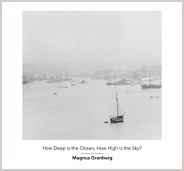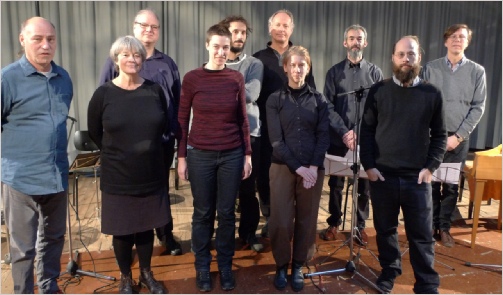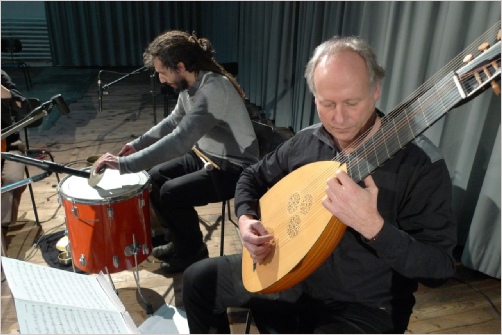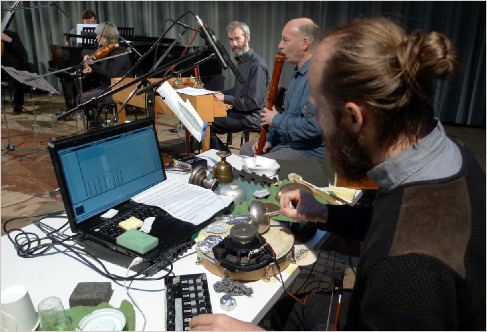Another Timbre TimHarrisonbre
Magnus Granberg interviewed by Lawrence Dunn
‘How Deep is the Ocean, How High is the Sky?’ is your fourth composition to be released on Another Timbre. Listening to them all now, they seem to run into each other. It’s almost as if each piece feels like a picture of the same world, the same landscape, but seen from a different angle?
Yes, I think that’s quite a good description, and it’s very much how I perceive things myself, the pieces being different parts of the same place or landscape or being the same landscape but seen from different angles. That might of course be considered an inherent vice in my artistic output, but that’s how things are at this point at least!
Could you describe the music on this recording? How is it arranged?
Well, in a way you could say that the music is not arranged, at least not in a traditional sense. Perhaps one would rather say that it’s collectively and spontaneously organised: even though the musical materials (melodic fragments, chords, rhythmic patterns, pitches, timbres etc.) are specified to quite a large extent, the organisation of the material within a rough, temporal framework is very much a result of spontaneous processes and choices, individually as well as collectively. But the inherent possibilities of the piece are of course also very much an outcome of the nature of the musical materials themselves and all the different ways of combining them.
Why did you choose to use baroque instruments for this recording? With this kind of music, couldn't modern instruments be used to much the same effect?
The suggestion to use baroque instruments came first from spinet player Christoph Schiller, who initiated and organised this project. He had this idea of making use of the particular properties of the music scene in Basel, which is partly characterised by the presence of the Schola Cantorum Basiliensis, founded by Paul Sacher in the early 1930s. So, many of the musicians taking part in the Basel scenes for improvised and contemporary musics have studied there and also play period instruments outside the context of early music. Christoph and I thought it might be interesting to make use of that. Of course it would be possible to perform this music with modern instruments as well, but I find the particular timbre, projection and dynamics of the baroque instruments as fitting as they are interesting, for example the many possibilities writing and playing natural harmonics on the chitarrone and the bass viol, just to mention one aspect of their particular characteristics.
Across all four of your discs on Another Timbre there’s certainly a continuous study of melancholy. As you said in a previous interview, Italo Calvino described melancholy as ‘the sadness that takes on lightness’. But I’m attracted to the idea that, in Dowland say, melancholy is a kind of deliberate affectation, a kind of Weltanschauung of its own - that seems anathema to us today. Maybe we can’t understand why someone would choose not to pursue happiness.
Melancholy is obviously quite an elusive concept whose meaning has differed through the ages and I guess, like in Wordsworth, melancholy could be described as ”a treasured and luxurious gloom of choice”. But I would rather like to suggest that melancholy perhaps also could be described as something like a mood (or even a mode) which arises from the self’s reconciliation of the meeting or confrontation of one’s desires with the realities of life. And, on a side note, maybe happiness is something which just happens rather than something which is achieved when actively pursued? I myself would say that pursuing things is quite often a source of unhappiness, regardless of whether you succeed or fail.
With ‘the sadness that takes on lightness’ - is this music that has an oblique, resigned sense of humour about itself? Certainly the overly-affected melancholic was quite fit for mocking - in Romeo and Juliet, say. Robert Burton’s Anatomy of Melancholy was a very serious medical study; this can seem quaint to us now, and it’s not helped that he was mocked by Sterne in Tristram Shandy. But is the music of Skogen completely serious? - how is this lightness buried in them? (I’m recalling the ducks on the cover of Anders Dahl’s Rows.)
Well, I don’t know if I could honestly say that the music has a sense of humour about itself, at least not in the modern sense of the word, even though I do wish I could! I’m very much in sympathy with Joyce’s remark on comedy as being the greatest form of art, thanks to its capacity to make man forget about himself, his sorrows and desires. But I don’t think humour or comedy are necessarily the only ways of achieving lightness, of letting go of one’s concerns and cravings. I think this sense of lightness may also be experienced through the act of playing, through a certain degree of playfulness which I think perhaps might be considered part of the music as well.
I suppose it’s a cliche to regard the Feldmanesque mood as essentially ‘northern’, but I think it’s a definite, deliberate characteristic of these pieces. Post-protestant grey skies, long winters, Albrecht Durer. Schubert, ‘Ist gefallen in den Schnee.’ As a sort of antipode to your recordings with Skogen, I had in my mind the ‘choleric’ mood—forceful, aggressive, bloody, pliable, hot, catholic (ie. inclusive) - of Cremaster (Alfredo Costa Monteiro and Ferran Fages). What would it mean if Skogen played that noisily?
That’s an interesting question indeed, but as I’m not much of an expert on humoral pathology I think I should perhaps pass that question on to someone else, at least for the time being… But I’ll certainly mull it over in the future, I promise!
I have wondered about authorship with these pieces - your presence as coordinator, composer seems an important factor, especially given the relative constancy of mood and topic in these recordings. Is the notion of musical authorship relevant at all? - especially given that you’re working with improvisers with their own distinct presences.
Yes, the contributions and initiatives of the players are of course very, very important to the outcome of the music. But the pieces also consist of quite a lot of written material (rudimentarily notated in conventional staff notation - melodic fragments, chords, single notes, rhythms, dynamics, timbres etc.) which the players may choose from rather freely, and which they are encouraged to treat or improvise with in a number of different ways that are suggested in the scores. And the players all make quite different choices as to what degree they choose to improvise with or treat the material, all depending on factors such as experience, abilities or perhaps just personal preferences: there are many ways of approaching and functioning within the music, I think.
Like in your other pieces, the musical material is derived from an existing work, in this case Irving Berlin’s song How Deep is the Ocean, (1932). But Berlin is so kitschy, no? Is that an attraction? (Satie famously used Berlin’s That Mysterious Rag in Parade - if one used a first-rater, say, Gershwin or Ellington, as source material, its effect might be overwhelming…)
Yes, I guess you could say that Berlin is kitschy, but that’s certainly not an attraction in itself. But I think the ways in which these songs are interpreted within a jazz tradition (for example by Lee Konitz, Chet Baker or Billie Holiday) transcend its original kitschiness, and the impulse to use Berlin’s song as a source material stems more from the experience of listening to these interpretations rather than Berlin’s original version. But it’s also very interesting that you mention Satie’s use of rhythmic material from That Mysterious Rag in Parade. I had actually forgotten about that; the fact is that, apart from the Berlin material, I also derived much of the rhythmic material of How Deep is the Ocean, How High is the Sky from Satie’s Deuxième Préludes du Nazaréen, so maybe there’s some sort of subconscious connection between Satie and Berlin on my (and your?) part which is coming to light in this piece…
Email interview conducted May 2015

at87 Magnus Granberg - ‘How Deep is the Ocean, How High is the Sky?’ (2015)
for baroque instruments, prepared piano, objects and electronics
Magnus Granberg - prepared piano, composition
Cyril Bondi - objects, percussion
d’incise - objects, electronics
Teresa Hackel - bass recorder
Wolfgang Hillemann - chitarrone
Anna Lindal - baroque violin
Hans Jürg Meier - bass recorder
Anna-Kaisa Meklin - viola da gamba
Eric Ruffing - analogue synthesiser
Christoph Schiller - spinet, objects
Recorded in Basel, January 2015
Youtube extract CD copies sold out, but downloads available here






Reviews
“When I first listened to Magnus Granberg’s hour-long piece of music “How Deep is the Ocean, How High is the Sky?”, I thought it strange how the title suggested vertical measures, and yet the music itself presented a surface that my senses perceived as being somehow horizontal. The volume of the piece remains quiet throughout; notes are plucked or struck and allowed to decay (if from a stringed instrument or percussion), or held for a long time (if made with the breath or generated electronically); movement between notes is steady, and change slow. All of these features led to a sensation of being cast adrift on the surface of a calm ocean, following a line of time to a horizon reached mid-sentence.
The more I listened, however, the more the work’s vertical contours came into focus: the movement of pitch from high to low to high; the layering of instruments of different pitches, timbres, and historic periods (baroque and modern); the little swells of volume and intensity. If the music traverses musical time and acoustic space as words traverse a Western page, then it also unfurls like a Japanese scroll or a modern webpage, spanning centuries and kilometres in an instant. I got the sense that, like an ensemble score, the piece reads both ways, horizontally and vertically, simultaneously. So much of experience is understood and communicated through its representation as lines; to what degree is our perception of music also influenced by such representations? And what happens when those perceptions are subject to productive confusion and contradiction? Can tempo produce an impression of depth, and pitch an impression of flatness?
“How Deep is the Ocean” is the fourth album Granberg has released through UK label Another Timbre, the first three appearing under the name of the ensemble he leads, Skogen. The choice to record in Basel, Switzerland rather than Skogen’s base in Sweden, and to feature baroque instruments such as bass recorder, chitarrone, and viola da gamba, led to collaboration with a different group of musicians that included diatribes duo d’incise and Cyril Bondi. Granberg’s score gives responsibility for many different choices to its performers, meaning that the lines of travel heard on the recording are as much theirs as his. If we are to put these horizontal and vertical lines into slightly less abstract terms, we might say that they reflect both perceptions of landscape and perceptions of time. These reflections keep on broadening and deepening with each listen.” Nathan Thomas on Fluid Radio
“The Swede Magnus Granberg has rapidly become a key member of the Another Timbre family, this being his fifth album on the label in under four years, with four of those being his own compositions. Those familiar with Granberg's past AT releases will be delighted to hear that How Deep is the Ocean, How High is the Sky? follows the familiar pattern of the others. As before, it employs material derived from another song—in this instance, Irving Berlin's "How Deep is the Ocean"—but there are few, if any, traces of the original in evidence. Instead, the piece establishes a pleasantly melancholy mood that typifies Granberg compositions.
How Deep is the Ocean, How High is the Sky differs from past Granberg releases in the instrumentation used to perform it. As before, Granberg himself leads a large ensemble, a ten-piece this time with him playing prepared piano rather than clarinet. Again the ensemble includes electronics, objects and synthesiser alongside acoustic instruments, with the Swiss duo Diatribes—d'incise and Cyril Bondi—here present for the first time. Bizarrely, the ensemble features the distinctive timbres of baroque acoustic instruments such as spinet, viola da gamba, baroque violin and chitarrone plus bass recorders. Consequently, the resulting ensemble is an amalgam of the 18th and 21st centuries, one that sounds as if it might not work but actually succeeds well.
Granberg's composition is not rigidly scored but allows the players license to play the specified music when they see fit, within a rough temporal framework. This gives it a loose, relaxed feel that is so typical of Granberg's work it is immediately recognisable as his. Yet another winner from Granberg.” John Eyles at All About Jazz
“Magnus Granberg’s fourth composition for Another Timbre—and second album under his own name—borrows its title and some of its musical material from Irving Berlin’s “How Deep is the Ocean,” written in 1932 and recorded through the years by such luminaries as Ella Fitzgerald, Judy Garland, and Julie Andrews. Anyone who just listens to the music, however, might not realize that, because Granberg also looked to Satie’s “Deuxième Préludes du Nazaréen” for rhythmic inspiration. “Nazaréen’s” slow, even movements and muted dynamics are an obvious model for the suspended animation of Granberg’s hazy textures. The link to Berlin’s jazz standard resides less in its melodies and more in its lyrics, which pose a series of questions as an answer to the song’s first line, “How much do I love you?” Nobody sings on How Deep is the Ocean, How High is the Sky?, and it doesn’t pose anything like an obvious question, but the album’s unusual instrumentation and constantly shifting sound chip away at easy musical distinctions in the same manner that Berlin’s lyrics try to answer a question for which words are rarely sufficient.
Unlike anything Irving Berlin ever employed, Magnus Granberg’s orchestra is made up of nine musicians, not including himself, more than half of whom play an instrument that is approximately 400 years old. The chitarrone, bass recorder, viola de gamba, spinet, and baroque violin stick out almost as historical curiosities, especially on an album that sounds like it belongs more to this century than to anything in even the last 150 years, and which counts analogue synthesizer, prepared piano, various electronics, and unspecified objects among its instruments.
In an interview on the Another Timbre website, Granberg explains that the spinet player, Christoph Schiller, suggested using period instruments to reflect the music scene in and around Basel, where the album was recorded. The degree to which his suggestion succeeds depends on what the listener knows about Basel, Switzerland and the Schola Cantorum Basiliensis. The more immediate impression is that of deliberation and careful listening. Sounds often come one at a time, or in small increments, and at low volumes. Gestures wind up into the air then drop into silence like they’re tied to bowling balls. Mouse-like scampering occupies the place normally reserved for percussion and very slight electronic distortions murmur in the background as if they’re trying to be quiet during a lecture. The formality betrays the degree to which the music is composed, the seeming randomness of its development speaks to the improvisation on display. The album’s middle portion, especially around the 28 minute mark, is particularly formal. The sequence of events could have been scored for a radio play or a very tense theatrical scene, but it’s just one passing moment among many, perhaps an example of synchronicity and perhaps a calculated outcome.
The second, maybe less obvious impression is that of distillation, or of haunting. Satie and Berlin haunt the music in the sense that Granberg invited them to haunt it, but their presence isn’t obvious. Knowing that they are there at all helps only a little. Their remains are neither purified nor concentrated in the resulting concoction. Instead they are experienced at a remove, either as historical fact or as concealed musical ingredient. What’s left is a ghostly expression of emptiness, of instruments played in a museum, or of music sealed behind glass, which is not to say that it sounds artificial. At times the opposite is true: the music seems to play itself, or it presents itself as a physical fact, the consequence of gravity, solar flares, jet streams, and tidal forces. The human element slips into the depths and the elemental features of music, condensed into a few representative examples, float to the surface—where they tick away like a perfectly engineered clock in an empty room.” Lucas Schleicher at Brainwashed
“The invention of the wheel was an occasion for much celebration, one that we still talk about today even if we don't know the name of the Mesopotamian craftsperson responsible. And of course the creation went through many developments on its way from wheelbarrow to Prius. Anthropologists, in fact, believe that the ceramist wheel predated the locomotive wheel by a good three centuries.
If we have no record of the R&D team's activities some 3,500 years ago, we certainly don't know the names of those who made less orthodox, maybe even artistic, use of the wheel, those who weren't interested in its utility but rather the ways it might be altered to reflect or suggest something about the world, their world. Surely they existed, though, those creators of curious objects who, for example, wanted to find a way to make a tower of wheels, undermining their essential mobility, or who carved the surface at an angle so it could only roll in a circle. And then, no doubt, there were those who relished in the imprecision of construction: the rough surfaces and the inexact placement of connecting shafts. In fact, it may well be that from the uncentered axle rose the fascination with irregular repetitions.
This is, of course, all speculation (though does it not seem obvious?) because, as noted above, all records are long since lost if any were kept in the first place. Fascination with that asynchronous clickety-clack, however, has re-emerged in the world of post-Feldman art sound, a lovely example of which is Magnus Granberg's How Deep is the Ocean, How High is the Sky?. A tentet of musicians works in not quite predictable cycles, rarely playing at the same moment in time, using a set of tools that spans centuries, from the baroque violin, chitarrone and viola de gamba to the prepared piano (played by the composer) and analogue synthesizer. With one musician playing percussion and another on electronics, and both of them plus a third credited with "objects," it's hard to guess the origin of the occasional, uneven ringing that anchors the piece like a nautical bell falling into irregular rhythms with the rocking of the boat, an image which calls to question the Mesopotamian origins of this quite beautiful record.”
Kurt Gottschalk, Squid’s Ear